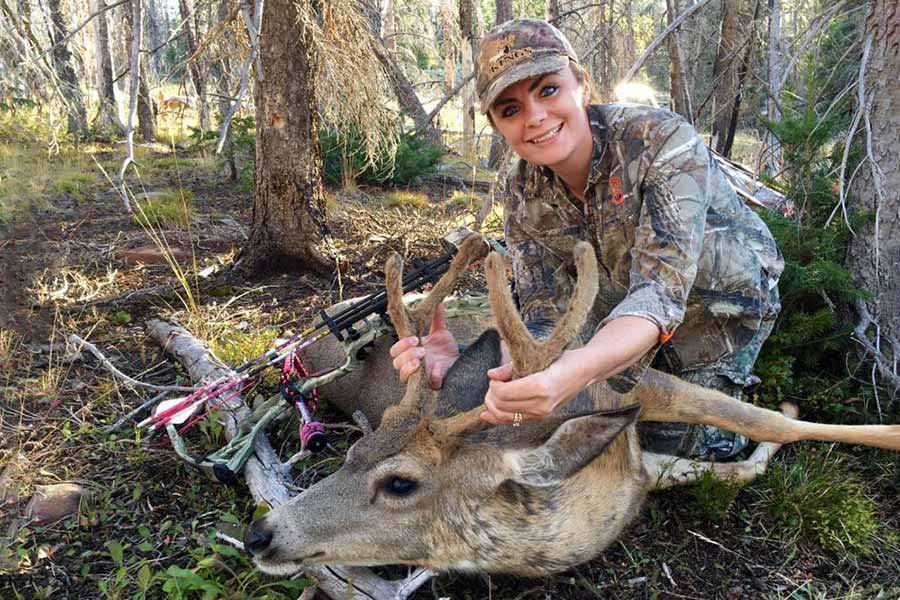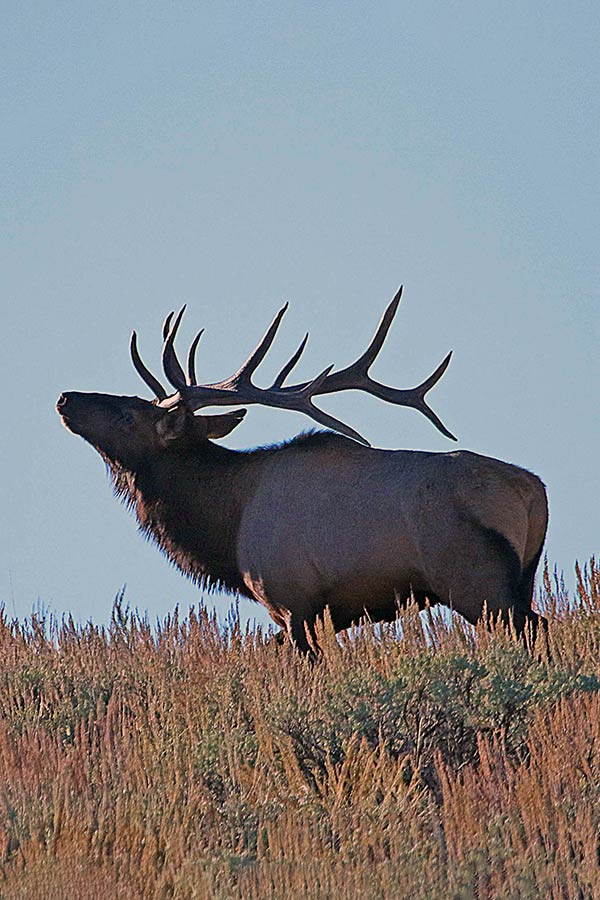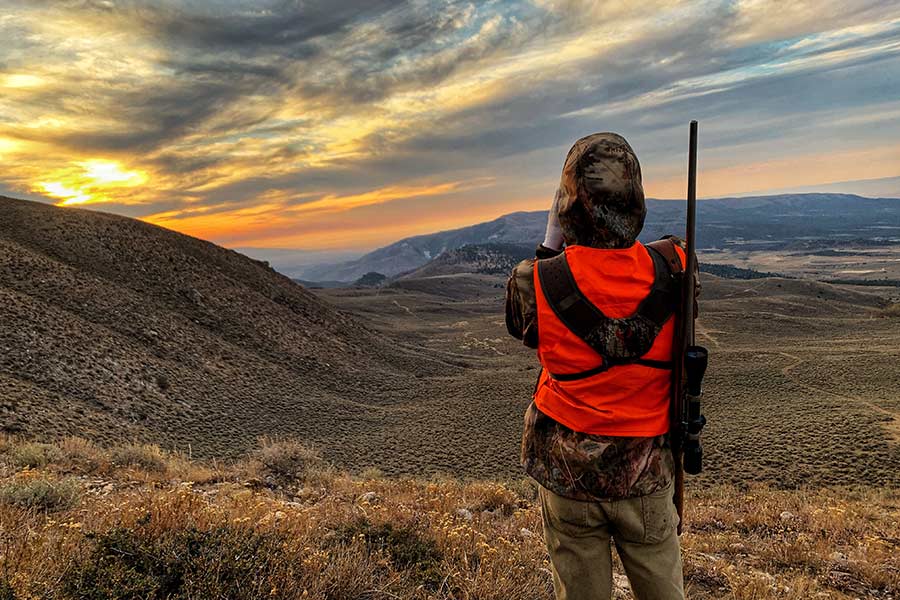What hunters should know for the 2023 Utah deer and elk hunts
Salt Lake City — Several years of drought conditions and then the record-breaking snowfall last winter have impacted mule deer populations in certain parts of the state more than others. Here are a few things people hunting deer and elk in Utah this fall should know.
The general-season buck deer archery hunt and the general spike and any-bull elk archery hunts are the first big game hunts of Utah's fall season, and they all begin Saturday, Aug. 19. New this year, the general-season any-bull elk hunt (with any legal weapon) is split into two seasons. The early-season hunt will be held Oct. 7–13, and the late-season hunt will be held Oct. 14–20. The general-season buck deer hunt (with any legal weapon) runs from Oct. 21–29, and the general-season muzzleloader elk hunt will be held Nov. 1–9.
Deer hunts
The current deer management plan includes an objective to have 404,000 deer across Utah, and the 2022 postseason population estimate is 335,000 deer in the state. While hunting bucks doesn’t impact the total population growth rate, the Utah Division of Wildlife Resources has decreased hunting permit numbers for the last several years, tracking with population-level declines, in order to better manage to the buck-to-doe ratios outlined in the management plans.
"There are a few things that can negatively impact deer populations in Utah," DWR Once in a Lifetime Coordinator Rusty Robinson said. "Those include poor or limited habitat and extreme weather — either ongoing drought or really heavy snowfall, like we had last winter. The most important factors that drive deer population numbers are the survival rates of doe deer (since bucks don't have babies), fawn production and fawn survival after the winter."
The deer hunting this fall will vary, depending on which areas of the state people are hunting. The deer populations in Cache, Weber, Summit and Morgan counties were hit pretty hard by the severe winter conditions and had lower survival rates of adult doe deer and fawns in those areas. The low survival in those hunting units will result in fewer buck deer — especially yearling bucks — being available for hunters in those areas this fall.
However, other areas of Utah — including southern Utah — had really favorable conditions this winter, which resulted in above-average deer survival rates and great habitat conditions this spring and summer. Hunters in those parts of the state should see a lot of huntable yearling bucks, as well as some older age class bucks in their hunting units.
Elk hunts
Elk are impacted differently by drought and severe winter conditions because survival of adults typically remains high, although pregnancy rates have been shown to decline during extreme drought conditions. The current statewide elk management plan includes an objective to have 80,000 elk across Utah — the 2022 postseason population estimate is 82,960 elk in the state.
Anyone looking for an opportunity to hunt elk in Utah should note that there are still some archery antlerless elk permits available. These permits allow a hunter to harvest a cow elk with archery equipment during the dates of the general-season archery elk hunt on those units. These permits are great for hunters who:
- Have an archery deer permit for a unit but would also like the opportunity to hunt a cow elk if they encounter elk. (The archery elk and deer season dates are similar, although not exactly the same.)
- Have a general-season archery elk permit and would like to harvest a cow and still be able to stay in the field to hunt a bull, as well, so they can harvest the meat from both animals.
- Always feel like they encounter cow elk when they have a bull permit.
"The DWR uses these permits to help manage the elk populations to the management objectives established in the management plan," Robinson said. "Hunting pressure from archery hunters doesn't change the elk distribution on the landscape as much as rifle hunting, which often pushes the elk herds to inaccessible areas. These permits and antlerless hunts are a good strategy to help with elk harvest in certain areas that need to balance the number of animals with the available habitat."
Hunters should also note that many areas of Utah have more abundant water sources this year — due to the record-breaking snowfall — so deer and elk will likely be more spread out on the landscape, making them more difficult to locate and pattern. As a result, hunting near water sources may not be as effective this year because there are more water sources available than usual.
Whether you are a first-time hunter or a seasoned veteran, it's always a good idea to get a refresher on things that can help you be successful during your hunt. If you are planning to hunt deer or elk in Utah this fall, here are some tips to help you be successful during the archery and rifle hunts:
Do your research before heading out, know the laws and scout the area in advance
It is a good idea to visit the Utah Hunt Planner before heading out into the field. This great online resource includes notes from the biologists who manage the various hunting units across the state, as well as general information about the units and safety and weather items. You can see information about the number of bucks on the units, compared to the number of does. You'll also find maps that show the units' boundaries, which land is public and private, and the various types of deer habitat on the unit.
"Hunters who have scouted their hunting units and spent time locating animals before the hunt begins are typically more successful at finding, pursuing and harvesting an animal during their hunt," Robinson said. "Spend time scouting, and if you haven't, consider planning multiple hunting trips during the hunting season. Treat your early hunting dates in the season as hunting and scouting, and try to cover lots of ground to locate animals."
As a reminder, there are a few changes to big game hunting this year. Here are some of the new laws to be aware of:
- Trail cameras: The Utah Legislature updated the rules regarding the use of trail cameras in Utah, which took effect May 3. All trail cameras are prohibited on public land from July 31 to Dec. 31, with a few exceptions. A trail camera using internal data storage and not capable of transmitting live data is still permitted for use on private land for the purposes of legal hunting.
- Mandatory harvest reporting for antlerless hunts: This new rule requires that hunters report their harvests in Utah's antlerless big game hunts. Hunters will have 30 days to report after the hunting season ends, either online or over the phone. Anyone who doesn't complete the mandatory report will be excluded from the antlerless drawing the following year. Late reporting will result in a $50 fine in order to reinstate eligibility for the antlerless drawing. This change came as a request from hunters, so the DWR will have more-complete harvest data to use when setting permit numbers.
- Game retrieval and meat salvage requirements: These rules require a hunter to physically check the area where they shot at an animal to see if the animal was killed or wounded before the hunter leaves the area. If a hunter does harvest an animal, they are required to harvest the meat from the front quarters, above the knee; from the hind quarters, above the hocks; and along the backbone — between the neck and hind quarters — including the loins and tenderloins.
- Paunsaugunt Unit changes for elk hunting: In December, the Utah Wildlife Board approved changing the Paunsaugunt Unit from a limited-entry elk hunting unit to an any bull elk unit, but removed the archery hunting portion from the "any bull" seasons. Hunters may still hunt the any-legal weapon and muzzleloader hunting season dates with a valid any bull permit, but can not hunt the archery dates. This was implemented in order to avoid crowding conflicts with the premium limited-entry archery deer hunt on the Paunsaugunt unit.
- Weapons technology changes: Several regulation changes were also approved by the Utah Wildlife Board to Utah's allowed weapons technologies, including prohibiting attached electronics (except for illuminated reticules) on most weapons. To see all the changes, review pages 45–58 of the 2023 Utah Big Game Field Regulations Guidebook.
For information about all the new changes and laws for hunting big game this fall, hunters should check the 2023 Utah Big Game Field Regulations Guidebook.
Practice with your equipment
Whether you are archery hunting or using firearms, it's a good idea to practice regularly with your equipment so you are familiar with it and have the skills needed to hit your target.
"Making responsible and ethical shots is an important part of using our wildlife resources wisely," Robinson said.
Hunt away from the road
If you are hoping to harvest a deer or elk this fall, make sure you are hunting in areas away from the road.
"Elk are smart and know how to avoid hunting pressure. They avoid roads, so especially when you are hunting elk, get off the road," Robinson said. "Get out and do some hiking and scouting to find where the animals are."
Look for rugged terrain
When it comes to deer, mature bucks and does are not together during the August archery hunts. So if you are seeing a lot of does in an area, it's a sign that you should probably move to a different spot. Does have to care for their fawns, so they typically prefer areas where there is a lot of water and the terrain is more gentle, like in rolling aspen groves.
"Bucks will gather in herds of little 'bachelor groups,' and they like more rugged mountain terrain," Robinson said. "So, if you are looking for a bigger buck, look for terrain that is harder to access."
Pay attention to the direction of the wind
Another tip for archery hunters is to know the direction of the wind. That way, you can make adjustments and prevent your scent from reaching the animals before you get within range. As the sun heats the ground, the wind direction changes. For example, wind almost always blows up canyons in the morning and down canyons in the afternoon.
To know the direction the wind is blowing, you can buy an inexpensive item called a wind or breeze checker. Releasing powder from the checker will let you know the direction the wind is blowing. Once you've determined the direction the wind is blowing, approach the deer from the side (a 90-degree angle) rather than approaching it with the wind in your face (at a 180-degree angle). If you approach with the wind in your face and then the wind shifts and starts blowing from your back, it'll blow your scent directly to the deer. Approaching from the side reduces the chance that a wind shift will carry your scent to the deer.
Be prepared for the weather and possible emergencies
You should also be prepared for any weather and should always have a first-aid kit and plenty of water. The weather in Utah's mountains can change very quickly and go from sunny to snowing in a matter of minutes, so you need to be prepared with adequate clothing and supplies.
"We urge hunters to remember the safety basics of hunting with a partner and always make sure someone knows where you are and when you will return," Robinson said. "You can't always rely on cell phones as they may not have reception in the backcountry during your hunt."
You may also want to have a bug net or bug spray available this year, as the increase in water from the record-breaking snowfall has resulted in more mosquitoes in certain parts of the state.
Use binoculars and be stealthy
Having success during the archery hunt requires stealth and patience. For example, if you're going to use a spot-and-stalk method, don't just walk through the woods, hoping to find a deer without spooking it. Instead, spend time looking through binoculars at an area to find deer and locate where they're bedding. Then, after they've bedded down, plan your stalk, remaining quiet and doing all you can to approach the deer at an angle that keeps your scent from reaching them.
"Stealth and knowing the wind direction are more important for archery hunters than for rifle hunters, as archery hunters need to get closer to the animal to be effective," Robinson said. "It all depends on the hunter and their skill level, and equipment, but typically, most bows have sights that allow for shooting at 60 yards or less. And typically, the accuracy of most rifles starts to decline between 300–400 yards. I recommend not trying to 'overshoot' with your equipment and to stick with a distance where you have practiced and are comfortable. You should also always know what is beyond your target before taking a shot."
Keep the meat cool
In hot temperatures (especially during the archery hunt), meat from harvested animals can spoil quickly. It's important to get the meat cooled down as soon as possible after harvesting the animal. Removing the hide from the meat and removing the meat from the bone will help. After that, you can use a cooler to lower the temperature of the meat in transport.
"Dry ice can be used to cool the meat quickly and keep it cool for a prolonged period," Robinson said. "You want to keep the meat as cool as possible until you can process it and get it into your freezer."
"Hunting should be fun, and you should enjoy it. It's a great time to see Utah's amazing wildlife and to make memories with your family and friends. Get outdoors this fall and have an adventure or two in our beautiful state."



















